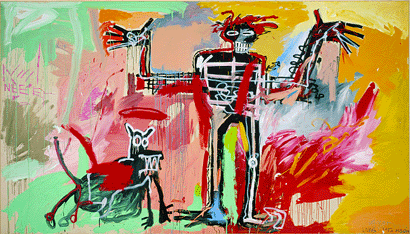The disquieting experience of Jean-Michel Basquiat at the Brooklyn Museum
Undeniably, Jean-Michel Basquiat (1960-1988) was one hell of an angry guy, but it is also true that this man who died very young was one of the most vibrant and alive artists of his time.
Yet during what proved to be a very short, but prolific career, he faced challenges that not only curtailed his longevity but also shaped, and perhaps stunted his legacy. After his burst onto the artistic scene, he became the only commercially successful young African-American working artist and his concerns were shaped by the prevailing attitudes toward race in this country. Much has also been said––deservedly so—about his destructive dance with drugs.
But perhaps the most important factor in determining the tenor of his legacy was the degree to which his work was commodified from the start by the art market. To his dealers, it mattered little whether Basquiat thought his work was complete when it was put up for sale, and it certainly wasn’t essential that any critical judgment about the work had yet been rendered.
The 100 or so paintings, drawings, doodles and work sketches now on view at the Brooklyn Museum, through June 5, offer a somewhat complete and competent overview of his work. The way Basquiat represented his heroes––Charlie Parker, Joe Louis and Sugar Ray Robinson, among them––has been much commented on. To him, they were kings and saints. But look too at the techniques he brought to his work, especially the way he layered them with paint and densely filling them with words and images he blended together, his own signature technique. Another fascinating recurring image was the starkly delineated head, an expression of the ways in which he understood how what is inside of us is bursting to come out.
Another striking feature in Basquiat’s work are the frequent references to money, ownership and their associated symbols.
At the age of seven, Basquiat was run over by a car and spent a long time recuperating in a hospital with a broken arm and damage to many internal organs that eventually led him to lose his spleen. During this time, his mother introduced him to “Gray’s Anatomy,” and he would later name his band Gray. The young Basquiat developed a fascination with human anatomy and it found echoes later in his rendering of internal organs and the human skeleton in his paintings.
What you will also see in this exhibit is how Basquiat’s connection to New York City found expression in the gestures in his paintings that remarked on the repeated forms, textures and colors found in the cityscape. He saw doorways, the partially visible sky, the cuts tenement rooftops cast against the skyline and the textures that predominated in building materials.
Basquiat began as a graffiti artist––and he never left that legacy behind. He was known at first as SAMO. Graffiti is about using language to mark a spot, to say something about the ownership of a location or about oneself. Basquiat’s interest expanded from the tagging of buildings to the tagging of a canvas, a series of panels or whatever surface he decided to own.
He used language at the start and became more and more playful with it. You can see in many of the working sketches how he created for himself a vocabulary that was at times funny and could also speak about the commercial demands of art. Not the most interesting, perhaps, of topics to make art about, but that was what he chose to do.
Basquiat was interested in fame and money; he wanted what it would buy him and what he could do with it. He threw his lot in with another very successful marketer of his time, Andy Warhol, and was represented by dealers who had a gift for marketing art.
One of the results of this focus by Basquiat is that his artistic legacy is characterized by his persona, not his creative output. Many recent articles about art exhibitions, like the current one at P.S. 1, where Basquiat was discovered, discuss issues such as the market and auction value of a work of art and how long the waiting line is for the work, rather than what the works on display have to say themselves.
A recent article in the Village Voice took to task the marketing of Damien Hirst’s show at Gagosian because of the emptiness of the work itself. Mary Boone, Basquiat’s dealer, perfected sale techniques that turned artists like him into commodities, establishing a stock market of sorts that made money on the sale of works and then again on their resale.
Basquiat knew how his work was sold. We see it on those canvases where he commented on art being now about money. In fact, he had a canvas that said “five thousand dollars”—that was what the canvas sold for and that was also the content of the work itself. For Basquiat, much of the fervor that was stirred up to sell his work contributed to the concerns that he ended up making art about.
We know about Basquiat’s attitude, his teaming up with Warhol, the ultimate marketer, but when we focus on that side of the work, we lose our memories of the power of other paintings. When I wandered through the rooms filled with Basquiat’s works, I couldn’t help but feel energized by the way he attacked the canvas. The paintings that were explicitly about the African-American experience––there are many of them––used, for example, tar and feathers to show how blacks were treated.
He also used the words themselves-––tar, asbestos and others––-because his graffiti side never left him. But Basquiat’s graffiti became more sophisticated––and perhaps cynical––as he began to use the copyright symbol. For example, the word milk is tagged with a copyright so he can show that he owned not just that substance but the word, too. We see again and again how he used both language and images to drive the power of his vision deeply onto the canvas.
There were several African-American boys in the galleries the day I visited the museum. I followed them for a bit. We were in the last gallery of the show and their bodies seemed filled by the kinetic energy Basquiat engendered. These kids hit the walls, bounced into each other and began pointing at the Batman symbol in one painting and to the “S” for Superman in another and then, laughing, they raced out of the space. Their completely physical response to room upon room of high-energy work struck me profoundly. The energy was so present in the air, in the constant dissonance of the images and words.
No one can ignore the reverence Basquiat had for his heroes, how he represented the mistreatment of the black man in this world and how he was able to make an art that was cognizant of how language as well as imagery can be combined to show us this experience.
It is impossible not to react viscerally to the energy that comes off the walls and fills the rooms at the Brooklyn Museum. It is unfortunate that we also have to think about the marketing and manipulation of his work and how it became both the subject and the undoing of Jean-Michel Basquiat.
gaycitynews.com


































